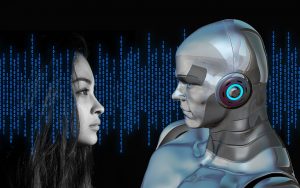When asked, “What will classrooms look like in 10 years? 20 years?” What do you picture?
In my opinion, it’s hard to picture anything but a classroom similar to the ones that students learn in now, but that question is a bit misleading; at the rate of technological advancement we’re seeing in this century, will there even be physical classrooms in 20 years? Will teachers be able to teach from home through holograms? Will students be able to receive a full education through online classes?
Think about it… paper is rarely used in education today; many schools have one-to-one laptop programs, and others have iPad/laptop carts in the school for students and teachers to use. There is still the occasional use of paper, but with pushes to use less paper in hopes of preserving trees, paper use is certainly not what it use to be. Is it that far out of reach to say that paper won’t be used at all in 20 years?
Click This to See One School's One-to-One Laptop InitiativeThese are the type of questions we’ve been challenged to consider this past week in ECI 201. What will the future of education look like?

Although there are many aspects of the future that remain a mystery, there are some that are already being worked towards that are very attainable, and predicted to be put into place in just a few years. I’ve done some research and described a few of the future classroom items that I feel are most possible.
1. Every Student Has a Tablet
It’s been happening over the past couple of years, and it’s only growing. So many schools have sets of laptop carts and iPads, and some schools even have carts of tablets for every classroom. Just like the one-to-one program listed above, a plethora of other schools are doing the same thing.
Click this link to read about a school district in Maine that plans on buying an iPad for every kindergartner.If you take a look at the article above, a small school district in Maine is working on outfitting an iPad2 for every kindergarten student in the district. The school leaders who are pushing for the iPads believe that they will be extremely helpful in facilitating learning in a creative way that will encourage students to be engaged, and that the iPads offer copious amounts of apps and games that can make learning for the children fun. At the touch of a screen, students will have access to more educational resources than ever before.
The main problem they face is cost; most people who aren’t in favor of the new plan are simply worried that $200,000 is too much for the smaller school district to pay for. This is not a rare problem. While technology is becoming the center of education as it offers so many opportunities that weren’t available before, the gap between those who can afford it and those who can’t is widening. However, districts who are determined, such as this one in Maine, are willing to fundraise and apply for grants as much as they can to attain their goal of a tablet for every student. I am convinced that in 10 years, tablets will be as common as pencils and paper.

2. The Extinction of Handwriting
As I’ve already stated, the riddance of pencil on paper penmanship isn’t far out of sight, and with school districts around the country trying hard for students to have their very own tablet to use, there won’t be a need for paper and pens/pencils! Teachers are teaching their students how to be successful in the real world, and this is an age of technology. Knowing how to properly format an email rather than write a letter is becoming more and more important, and this aspect of changes in education seems the most realistic to me.

3. Personalized Learning
Recently, at a technology conference in Austin, Texas, Bill Gates campaigned for more “personalized learning”. Some students are visual learners, some auditory, or tactile, etc., and the way a student learns best can really affect their school experience. Bill Gates, and millions of others, believe that schools need to start doing what they haven’t really done in the past: catering to students’ individual learning styles. While it can be difficult to ensure that all students are learning at the same pace with personalized learning, Bill Gates and others are raising funds in order to “help the company develop a program that allows the instructor to keep track of a student’s performance, so he can determine the best intervention for the learner.” I believe that with this being a rising concern among the public and influencers like the Gates, that the future holds more options for students to optimize the way that they learn. Personally, I think it’s about time students have a say in their early educational careers!
This fact sheet/journal summary paints a broad picture of schools’ efforts to implement personalized learning and understand the outcomes: https://k12education.gatesfoundation.org/resource/continued-progress-promising-evidence-on-personalized-learning/

4. Lastly...Robot Teachers?
Okay, okay, this one might be a little bit silly. But really… isn’t it possible that at some point in the future, there could be robot teachers? I mean, we already trust robot cars!
What I really mean by this one is that technology is so advanced now, in a few short years, maybe it’ll be possible that teachers could teach from home through holograms! It’s already happened in classrooms in London: https://www.standard.co.uk/news/london/holograms-of-teachers-beamed-into-london-classrooms-from-around-the-world-a3449181.html.
They call them “humagrams”, and say that “A HumaGram is a hologram that you can interact with and it’s extraordinarily lifelike. “… kinda creepy, huh?
I know it sounds like something out of a sci-fi movie, but it seems like every piece of technology that we have today would have seemed like something out of a sci-fi movie to someone 30 years ago! We have hoverboards, self-driving cars, phones that can access the internet without wifi connection, etc.
But back to robot teachers… they aren’t far from being reality. This school in Germany has a robot teaching assistant named “Yuki”, and she’s considered a pioneer in robot education. Watch this video about Yuki if you’re interested:
Personally, I found it hard to believe when I saw this video, but I’m not surprised at the rate at which technology in education is growing. Are robot teachers on the rise???

Okay… I’m done talking about the scary realities of robots taking over the world. In general, nothing about the future can be guaranteed, but based on some research and readings I’ve done, these are just a few feasible things I can foresee taking place in the education world in the near, or far, future.
Ironically enough, I had never considered what education might look like in the future before this class. I certainly should have, considering that’s what I’ve chosen my career to be, but I guess I’d always imagined that nothing would change. I had assumed that I would be teaching in the same environment that my teachers taught me in, but this isn’t the case. It’s so important to take into account how the future of education might look, because that’s what I’ll be working in every day. Of course I’ve got my fingers crossed that robots don’t take my job away, but more realistically, my teaching environment could be so different that I’m working from home through a hologram. I need to be able to prepare for whatever things are thrown at me in the future, which means I need to consider what could be when I have my own classroom, and that’s why I’m thankful for our discussion of the future of education in class.
One thing that I’m certain of is that the future of education will be technology ridden, and that is one of the best ways I can begin preparing myself to be adaptable to the future classroom. I know that my students will need to be able to navigate technology and the internet to do well in their futures, which is why I’m taking classes like “Intro to Instructional Technology” and keeping an eye out for new tech that could be utilized for learning. Using things like virtual reality in my future classroom is something that I’m so excited to try, but unless I had considered that the future would allow me to use virtual reality in the classroom, I wouldn’t be prepared to do that.
So, basically, think about the future. Not just your future, but the future of your students, and the future of your field of work, because the students that you will have will rely on you to be ready for whatever that future brings (whether there are pencils or not).

Also, if you want to hear more about what I think the future of education might look like, take a look at my voicethread called “Classrooms of the Future”!:
My Classrooms of the Future VoicethreadClassrooms of the future websites:
https://www.educationworld.com/a_tech/how-school-will-be-different-in-10-years.shtml
https://rossieronline.usc.edu/blog/education-20-years/
All pictures from pixabay.
Comments by oafrost